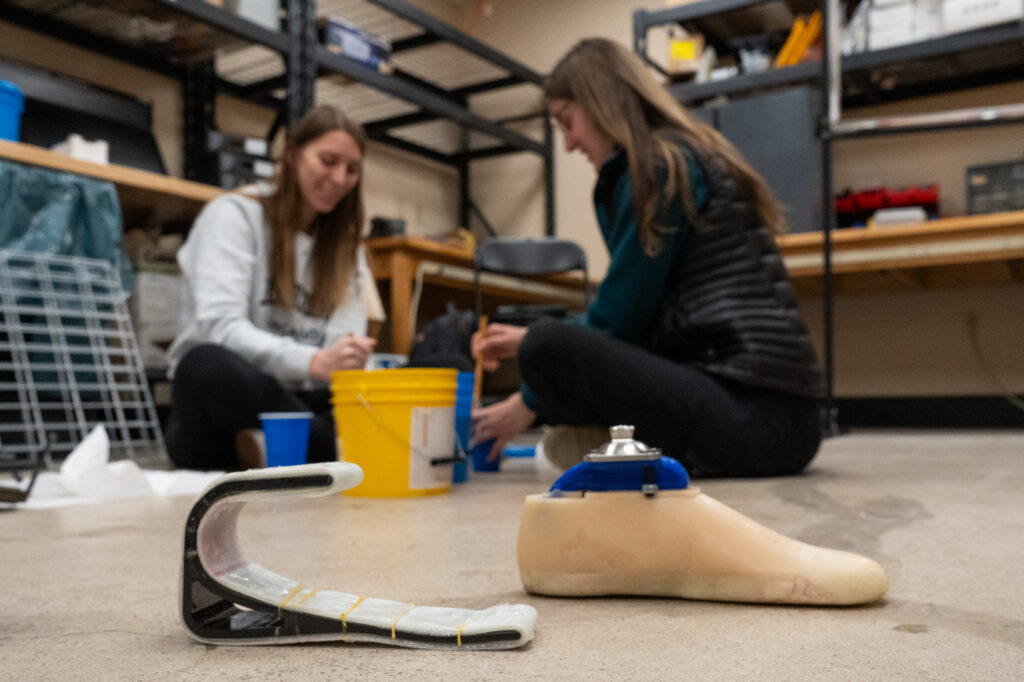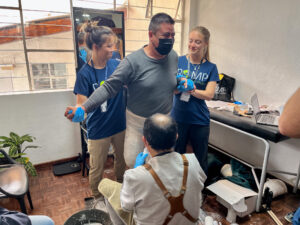
Walking to school. Running around with friends. Playing Soccer. Going to work and providing for your family.
For an able-bodied individual, these can be routine tasks, but for others, these tasks can seem impossible. Catherine Burr, a mechanical and biomedical alumna (’23), has witnessed first-hand the devastating reality for people enduring limb loss, especially those from low-income countries.
During an education abroad trip to Ecuador through CSU’s School of Biomedical Engineering, students work alongside the nonprofit, Range of Motion Project, to fit people with amputated limbs with custom prosthetic limbs, which are then attached to donated prosthetic feet. As a Spanish speaker, Burr also kept the patients company and listened to their stories.
“One man worked in telecommunications, and his fiber optics cable touched one of the high voltage lines, and he was shocked with something like 15,000 volts of electricity,” Burr said. “It’s a miracle he’s even alive, but as a result, he lost both legs. While waiting for his prosthetics, he was telling me that he really needed legs again so that he could get back to work and provide for his family.”
An added challenge of limb loss is affording the prosthetic. In the United States, without medical insurance, a lower-leg prosthetic limb can range from $10,000 to $70,000.

Clinics like the one in Ecuador are also often donation-based, meaning the supply of prosthetic feet doesn’t always fit the demand of patients, leaving people without proper and necessary medical devices.
As a rising senior in engineering, Burr had an idea.
“Senior Design is such a unique opportunity,” she said. “I really wanted to seize the opportunity and for it not to be just a graduation requirement, but to really have an impact on people’s lives.”
Year one
Burr applied for Senior Design venture funds through the Walter Scott, Jr. College of Engineering to design a low-cost, prosthetic foot that clinics could replicate to make custom prosthetic feet for their patients.
Over a year, Burr, Jacqueline Gedney (mechanical engineering) and Brayden Jonswold (mechanical and biomedical engineering) developed a working prototype. Their foot tested well against prosthetic feet on the market, but there was room for improvement. The prototype was missing an outer shell and was not durable enough for long-term use.
Year two

Although Burr graduated, she stayed on the project as a mentor and worked with the project’s second-year team of mechanical and biomedical engineering students Joyce Bohn, Declan Buggy, Ali Hamid, and Kalaina Stroyan.
The team helped improve the previous prototype and developed a low-cost, time-efficient manufacturing system. The system is intended to help clinics manufacture custom foot prosthetics in-house.
The idea is that with this process, clinics can create a custom foot in three days with only two hours of manual labor, using a 3-D printed mold and rubber-like urethane or resin.
Both the first and second-year teams partnered with Garrison Hayes, a mechanical and biomedical engineering student who uses a lower-limb prosthetic, to test their designs. Hayes tested the second-year team’s final prototype at a gait lab to measure the prosthetic’s effectiveness in terms of comfortability and pressure distribution.
The gait lab results indicated that StepUp’s prosthetic was more effective than Hayes’ current one, which cost him $7,000.
“The team surpassed my expectations, and I was super excited with the progress that they made,” said Burr. “Their foot can support up to 600 pounds and went through 7,000 cycles of testing without the protype failing. They made a really good product.”
Steps forward
StepUp recently received its nonprofit status, allowing it to continue fundraising to improve the product.
Burr says she hopes to continue the project next year with a new group of senior design students. That could mean beginning clinical trials of the manufacturing system and prosthetic foot in Ecuador, then using the data to iron out any kinks.
Burr wants to make a difference in people’s lives.
“The goal of this is to make prosthetics as affordable as possible. The impact I see prosthetics having is a dad gets to go back to work and provide for his family, or a mom can commute to get water or go to the market, or a child gets a foot that allows him to walk to school. That’s the biggest impact I could have, is giving them access.”